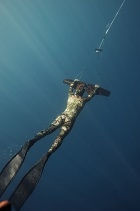Subwing: New Superyacht Toy?

SUBWING is a product invented by 20 year old Simon Sivertsen during a sailing trip in the Mediterranean in the summer of 2010, and started originally as a single piece of driftwood.
Subwing gives you the opportunity to explore the ocean in a way you have never done before. Choose your own pace and glide directly above the ocean sand floor, do thrilling twists and turns, or simply cruise along at the surface.
You can easily control the movement of the Subwing by tilting the two independent wings in various angles, making it easy to achieve dives- up and down, sideways movements and spins.
The Subwing is attached to a boat by rope with a recommended length of about 50 ft. The slow towing speeds of about 2-4 knots feel anything but slow underwater and are enough to provide a thrilling experience.
The intuitive and responsive manoeuvrability of the subwing makes for a safe and gentle learning curve where the rider is always in full ocntrol of when to dive or resurface, and a small boat will have no problem towing the Subwing.
Useful facts regarding SUBWING
-
SUBWING consists of two wings which can be rotated independently of each other, and are being pulled by a boat with a rope.
-
SUBWING works like wing rudders on an airplane; you control it by tilting the wings in different angles.
-
SUBWING is designed so it can be dismantled in the mid mount.
-
SUBWING uses Dyneema rope (the world's strongest rope) for maximum durability with minimum maintenance.
-
SUBWING is made in carbon with a hollow design filled with foam that it floats easily.
-
The rope attachments on the wings are mounted so that it becomes a force balance between the force from the rope and the force from the person who hangs on. Therefore it does not require much strength from the wrists to operate the wings.
-
Because of this you almost don’t use any muscles when operating the SUBWING, and as a result you can hold your breath for longer.
-
SUBWING has a rear grip that can be used to equalize ear pressure or whenever a hand is needed.
-
A beginner will usually only be underwater for about 10-15 seconds and will dive down to about 3 meters in depth. When one receives more training and can use the rear grip to equalize the ears, you can go deeper.

-
SUBWING is designed so that the head is well above water when lying in the surface position.
-
Normal length of the rope between the boat and the person in the water is about 10 to 20 meters, the longer the rope, the deeper it is possible to dive.
-
Normal depth that is “easily” achievable after some training is 5 meters and below.
-
Normal speed when operating the SUBWING is 4- 2 knots, it is possible to go faster, but the pressure on the neck from the water resistance on the head will be noticeable.
-
Using a snorkel is possible, but it is recommended to use a smaller, more streamlined snorkel to reduce the forces that pulls on the snorkel.
-
In colder water when using a wetsuit, it’s a good idea to place the collar of the hood on the outside of the suit to prevent it filling with water.
-
Normally a diving mask is the only equipment used when operating a SUBWING
-
SUBWING can be used by all sorts of people, from those who take deep dives and do thrilling "spins" underwater, to those who are most on the surface and at intervals take short dives.
-
SUBWING is the first thrilling watersport you can tow behind a sailboat or a slow boat in general. The speed needed to use the SUBWING is only about 3-4 knots, so any sailboat with any engine capable of doing this speed (which is practically any) can be used to tow a SUBWING.
-
It is important to mention that towing a SUBWING behind a sailing sailboat can be dangerous and is strongly discouraged because of the absence of being able to stop quickly.


Post your comment
You cannot post comments until you have logged in.
Login to post a commentComments
No one has commented on this page yet.
RSS feed for comments on this page | RSS feed for all comments